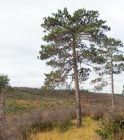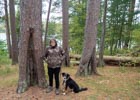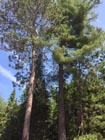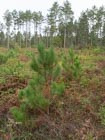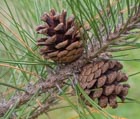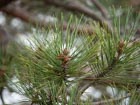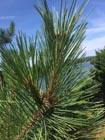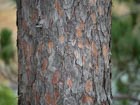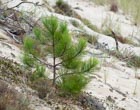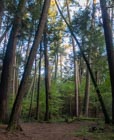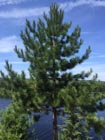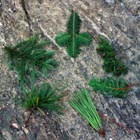Conservation Status

Pinus resinosa
Aiton 1789
Common names
Red pine, Norway pine, pin rouge (Kral 1993); bapakwanagemag, abakwanûgi'mûg (bark in plates) [Ojibwe].
Taxonomic notes
There are no synonyms; this has been recognized as a distinct species since its 1789 description, and is currently assigned to Section Pinus. A molecular analysis by Geada López et al. (2002) has placed it sister to P. nigra, in a far-flung clade that also includes P. densiflora, P. sylvestris and P. mugo.
There are no natural hybrids and, though artificial hybridization has been tried with a variety of species, it has found only very limited success with one species: Pinus nigra. Hall et al. (1975) state that "probably no other commercially important tree species has less intraspecific variability and is more difficult to hybridize with other species than red pine." This lack of genetic diversity was confirmed for the chloroplast genome by Echt et al. (1998), who found "evidence of one or more population bottlenecks", with greatest diversity observed in a population from New Brunswick. This result was later supported by nuclear microsatellite analysis that examined populations from throughout the species' range and found high inbreeding in all populations, but also one New Brunswick and two Newfoundland populations distinct from the remainder of the species (Boys et al. 2005). This evidence is consistent with the proposal that an ice-free refugium from Pleistocene glaciation existed somewhere in the vicinity of the Maritime Provinces (quite possibly on lands now submerged); evidence for such a refuge, based on patterns of genetic diversity, has also been found for P. banksiana and for a diverse suite of other plant and animal species (Godbout et al. 2010). Walter and Epperson (2005), looking at cpDNA evidence, reached a similar conclusion, finding the zone of maximum diversity to extend between the Adirondacks and western Nova Scotia.
Description
Monoecious evergreen trees to 37 m tall and 150 cm dbh, with a single straight, round trunk and a narrowly rounded crown of ascending branches. Bark light red-brown, furrowed and cross-checked into irregularly rectangular, scaly plates. Twigs up to 1 cm thick, orange- to red-brown, aging darker brown, rough. Buds ovoid-acuminate, red-brown, to ca. 2 cm, resinous; scale margins fringed. Leaves 2 per fascicle, straight or slightly twisted, brittle, breaking cleanly when bent, deep yellow-green, all surfaces with narrow stomatal bands, margins serrulate, apex short-conic, acute; sheath 1-2.5 cm, base persistent. Pollen cones ellipsoid, ca. 15 mm long, dark purple. Seed cones maturing and opening in 2 years, spreading, symmetric, ovoid before opening, broadly ovoid when open, 3.5-6 cm long, light red-brown, nearly sessile; apophyses slightly thickened, slightly raised, transversely low-keeled; umbo central, centrally depressed, unarmed. Seeds ovoid; body 3-5 mm long, brown; wing to 20 mm long. 2n=24 (Kral 1993). See García Esteban et al. (2004) for a detailed characterization of the wood anatomy.
Also see the Key to the Pines of the Southeastern United States.
Distribution and Ecology
Canada: Manitoba, Ontario, Québec, Prince Edward Island, New Brunswick, Nova Scotia and Newfoundland; and USA: Minnesota, Wisconsin, Illinois, Michigan, West Virginia, Pennsylvania, New Jersey, New York, Connecticut, Massachusetts, Vermont, New Hampshire, and Maine. Occurs on sandy soils at elevations of 200-800 (-1300) m (Kral 1993). It occurs within a zone near the Great Lakes and St. Lawrence River, most of which was glaciated during the Pleistocene, and today comprises the Laurentian (or Northern) Forest and the southern fringe of the boreal forest. Climate features average January/July temperatures of -11°C/18°C and average precipitation of 500-1000 mm, fairly evenly distributed through the year; this species is hardy to Zone 3 (cold hardiness limit between -39.9°C and -34.4°C) (Rudolf 1990, Bannister and Neuner 2001). Natural stands chiefly occur on acidic, sandy soils; on more fertile soils such as loams it typically is outcompeted by other species.
Distribution of Pinus resinosa based on observations and herbarium collections. Data sources include Conifers of the World, GBIF.org, and iNaturalist.org (accessed 2019.09.25).
Pinus resinosa occurs in pure stands, which may be extensive, or more commonly, with P. banksiana and/or P. strobus, and is common in stands dominated by each of these three species (Rudolf 1990). This species is shade intolerant and frequently occurs in even-aged stands. It often succeeds its less shade-tolerant and shorter-lived associates such as P. banksiana, Betula papyrifera, and aspen (Populus sp.) and is succeeded, typically after 300 to 400 years, by more shade-tolerant species such as P. strobus, Picea glauca, and Abies balsamea (Benzie 1980). Lichter (1998) provides a fascinating study of P. resinosa development on a chronosequence of successively older shoreline dunes on Lake Superior, finding the first pine seedlings appearing on dune 145 years old, with P. resinosa reaching maximum percent cover on dunes 400 to 440 years old. In native forests the dominance of P. resinosa is typically sustained by periodic fire. Moderate to severe fire creates an exposed mineral soil and little vegetation, conditions necessary for seedling establishment (vegetative reproduction has not been recorded in this species) (Hauser 2008). A study in Itasca County, Minnesota looked at forest response to frequent fire occurring from 1960 to 1970, thereafter ceasing. This work found that fire has persistent effects in the absence of further fire, including long-term reductions in the number of stems and likewise long-term increases in average stem size, effects that have persisted for half a century after the final burn (Scherer et al. 2016). In the south of its range P. resinosa is eventually replaced by hardwood species, and by shade-tolerant conifers in more northerly forests. In the Great Lakes region, succession may be from P. banksiana to P. resinosa to P. strobus and finally to northern hardwoods. On infertile, sandy sites, succession may end before hardwoods establish, and P. resinosa may persist indefinitely. In the eastern portion of its range, P. resinosa may be successional to forest dominated by Picea-Abies sp. or Tsuga canadensis. At its northern range limit in the boreal forest, frequent severe fires discourage P. resinosa establishment by killing trees before they reach seed-bearing age (about 10 years) and favor P. banksiana and Picea mariana (Hauser 2008). As is usual in forest ecology, these statements are generalizations, and stands frequently show complex structures and disturbance histories; as Fraver and Palik (2012) found in their reconstructions of stand histories in northern Minnesota, "The wide range of stand and age-cohort structures in these old-growth P. resinosa stands depicts pre-settlement forests more complex than those of the single-cohort, post-stand-replacing-fire model that has guided regional forest management."
Other associated tree species include Abies balsamea, Picea glauca, P. mariana, P. rubens, Thuja occidentalis, Tsuga canadensis, Acer rubrum, A. saccharum, Betula papyrifera, B. alleghaniensis, Fagus grandifolia, Fraxinus americana, Ostrya virginiana, Populus grandidentata, Prunus serotina, Quercus ellipsoidalis, Q. ilicifolia, Q. rubra, Q. alba, Q. prinus, and Tilia americana (Rudolf 1990). In outlying West Virginia populations, P. resinosa is most often a late-seral species on xeric rocky sites with Pinus pungens, P. rigida, and P. virginiana (Rudolf 1990).
Like most pines, this species is wind-pollinated; some self-pollination occurs, but because seed cones are typically borne in the upper crown and pollen cones on the lower crown, self-pollination is uncommon, although more common than in most pines as evidenced by the high inbreeding levels (see Taxonomic Notes). Trees may bear seed cones as early as age 5 and pollen cones as early as age 9, though highly productive trees are typically at least 50 years old. Seed crops occur in masts, with mast years commonly at intervals of 3 to 7 years; the largest seed crops are borne by mature trees in open forest or woodland settings. The primary insect predators on seeds are red pine cone beetle, red pine cone moth, and red pine coneworm, and these destroy most of the seed crop except in mast years. Viable seeds are dispersed by wind, with an average dispersal distance of 12 m and a maximum distance of about 300 m. Seed viability is brief; seeds evidently must germinate within a year of dispersal, typically in late spring or early summer, and require moist soils (Hauser 2008).
Although the conservation status is "least concern", Euroamericans have been hard on P. resinosa. Forests of this species covered about 40,000,000 ha in 1850, at the dawn of the settlement era; by 1995, cover was only 8,300,000 ha, a 79% decline. Late-successional forests formerly covered about 4,000,000 ha, but have now been reduced to a small number of small, scattered remnants (as discussed below in Observations). These reductions have come about through logging and fire suppression (Frelich 1995, Friedman et al. 2005), likely also with some conversion to nonforest land uses. 21st-century climate change is projected to further diminish the extent of P. resinosa forests, with projected mean temperature increases (3–11°C in summer and 3–7°C in winter [Kling et al. 2003]) that may shift the species' range 600–800 km northeast (Flannigan and Woodward 1994). Accomplishing such a profound range shift within the scope of the 21st century would, of course, require assisted migration (Williams and Dumroese 2013) to maintain the species within a landscape providing suitable climate.
Remarkable Specimens
American Forests (1996) listed a tree with diameter 100 cm, height 38 m, and crown spread 18 m, located in Watersmeet, MI; as of 2020, they do not list a record tree, seemingly indicating that the Michigan tree has died and no big tree is currently defined. Similarly, a "co-champion" to the Watersmeet tree grew in Itasca State Park of Minnesota, reaching a dbh of 97 cm and height of 38.4 m before losing its top in a 2007 windstorm and dying; the snag can still be seen. The tallest known one is in Hartwick Pines State Park, Michigan; it is 43.77 m tall (Rucker 2003). Few stands of big, old red pines survive, and there is a high probability that the current champion tree is in Itasca or Hartwick Pines.
A tree cut during powerline construction in 1992 proved to have a crossdated age of 500 years. This tree was near Kenora, Ontario (S. St. George, pers. comm., cited by Henry [no date]). The oldest (presumably) living trees are near Dixon Lake in Algonquin Provincial Park, Ontario, where specimen 082171 had 430 rings when collected by Ed Cook in 1982 (NCDC 2006).
Ethnobotany
The Flambeau Ojibwe would chop a hole into the trunk and collect the resin as it formed. It would be boiled twice, combined with tallow the second time, to make a waterproof pitch used for caulking canoes, mending roof rolls of birch bark, and other purposes. These people would also use it, when P. strobus was not available, for medicinal purposes. The bark medicine was gathered, with a song to grandmother Earth, and the placing of tobacco on the ground. The cones, when boiled and likewise the bark of the young tree trunk would yield a medicinal pitch called "jîngwak bûgîo." The dried leaves would be powdered and used as a reviver or inhalant (Smith 1932).
This was once the most important timber pine in the Great Lakes region (Kral 1993), and remains one of the most extensively planted species in the northern United States and Canada (Rudolf 1990). The wood is lightweight, close-grained, and white to yellow, with red to reddish brown heartwood. Easy to work, it is used for construction timber and pulpwood (Commercial Profiles of Ontario Tree Species). It is also used for nontimber products such as decorative pine cones and Christmas trees (Ciesla 1998). An attractive tree, it is also widely planted in landscaping, and it makes a good windbreak.
P. resinosa is useful in dendrochronology, and has been used in a variety of forest succession and fire history studies, e.g. Guyette and Dey (1995), Fraver and Palik (2012), and Bottero et al. (2017). Danzer et al. (2001) used it in anatomical studies.
Observations
In 2019 I did an inventory of various "old growth" resources for eastern North America, and identified the following sites as good for Pinus resinosa. I have visited some of these, as noted below. I haven't located information about good sites in Canada, though some must exist. If you want to delve, the Map of Ontario's Old-Growth Sites looks like a good place to start.
| Maine |
| Nahmakanta Reserve |
Reported by Davis (2003). |
| Michigan |
| Besser Natural Area |
Reported by Davis (2003). |
| Crawford Red Pines |
In Au Sable National Forest (Davis 2003). |
| Roscommon Red Pines |
Exceptional stand with easy access; also has P. strobus and P. banksiana (Davis 2003). |
| Sylvania Wilderness |
Exceptional stand (Davis (2003); many reports attest to the natural beauty of this area. |
| Tourist Park |
A site in the town of Marquette (Davis 2003). |
| Minnesota |
| Boundary Waters Canoe Area |
Reported by Davis (2003). |
| Dragon Lake |
In Superior National Forest, along with P. strobus and Picea mariana (Davis 2003). |
| Gustafson's Camp State Natural Area |
Occurs with P. strobus (Davis 2003). |
| Itasca State Park |
I visited this area. The "Preachers Grove" near park headquarters is an exceptional stand that has seen some level of management to reduce fire suppression effects; some excellent stands are also to be seen along the "Wilderness Drive", but all are suffering from a long history of fire suppression and the trees are showing signs of decline. Itasca is also an excellent place to see P. banksiana, P. strobus, Larix laricina, Picea glauca, and Thuja occidentalis. Also see Davis (2003). |
| Kabetogama State Forest |
Occurs with P. strobus (Davis 2003). |
| Kawishiwi Pines |
Area within Superior National Forest; occurs with P. strobus (Davis 2003). |
| Keeley Lake Research Natural Area |
Occurs with P. banksiana and P. strobus (Davis 2003). |
| Lac La Croix Research Natural Area |
Occurs with P. strobus (Davis 2003). |
| Lost Forty |
On this popular trail in Chippewa National Forest, P. resinosa occurs with P. strobus (Davis 2003). |
| Pine Point Research Natural Area |
This looks like a good site (Davis 2003). |
| Scenic State Park |
Occurs with P. strobus (Davis 2003). |
| New Hampshire |
| Mount Stanton |
Grows on cliffs and talus; also, Juniperus virginiana near its northern range limit (Davis 2003). |
| Pennsylvania |
| Tiadaghton State Park |
Reported by Davis (2003). |
| West Virginia |
| North Fork Mountain |
At this site in Pendleton County, along a ridgetop, P. resinosa reaches its southern range limit in mixed forest with P. rigida and P. pungens (Davis (2003). |
| Wisconsin |
| Brant Brook Pines State Natural Area |
Reported by Davis (2003). |
| Brule River State Forest |
Reported by Davis (2003). |
| Cathedral Pines State Natural Area |
I visited this site. P. resinosa grows to large sizes with P. strobus at a site that has experienced severe fire suppression; hardwood invasion is extensive (with locally abundant understory Tsuga canadensis) and the pines are senescent, with many standing dead and downed trees. See also Davis (2003). |
| Namekagon Barrens State Natural Area |
I visited this site, which Davis (2003) describes as "outstanding". The pines are not especially large but the area, which has very sandy soils and some recovery of a natural fire regime, is ecologically fascinating (see Anderson and Hlina 2019) as well as quite beautiful. It's also a good site for Pinus banksiana and contains bogs with exceptional Larix laricina and Picea mariana. |
| Spread Eagle Barrens State Natural Area |
Reported by Davis (2003). |
| Squirrel River Pines State Natural Area |
Reported by Davis (2003). |
Remarks
Norway pine is the state tree of Minnesota (Kral 1993). It was called "Norway" for the homeland of the men who logged it.
Genome mass is 5.6 pG, relatively high for a conifer (Morse et al. 2009).
The epithet means "resinous"; Aiton (1789) gives it the common name "American pitch pine tree" and the epithet probably refers to the pitch. Today the American pitch pine is Pinus rigida, and as there is no designated type, it is also possible that Aiton confused the two species; his description is sufficiently vague that it could apply to either.
Citations
Aiton, W. 1789. Hortus Kewensis vol. 3, p. 367. Available: www.biodiversitylibrary.org/item/23434, accessed 2011.05.21.
American Forests 1996. The 1996-1997 National Register of Big Trees. Washington, DC: American Forests.
Anderson, Derek S. and Paul S. Hlina. 2019. Preliminary Report on the Barrens Flora of the Northwest Sands Region of Wisconsin. Minnesota Department of Natural Resources. Available https://www.researchgate.net/..., accessed 2020.03.15.
Benzie, John W. 1980. Red pine. In: Eyre, F. H., ed. Forest cover types of the United States and Canada. Washington, DC: Society of American Foresters: 24-25.
Bottero, A., A. W. D'Amato, B. J. Palik, C. C. Kern, J. B. Bradford, and S. S. Scherer, 2017. Influence of repeated prescribed fire on tree growth and mortality in Pinus resinosa forests, northern Minnesota. Forest Science 63(1):94-100.
Boys, J., M. Cherry, and S. Dayanandan. 2005. Microsatellite analysis reveals genetically distinct populations of red pine (Pinus resinosa, Pinaceae). American Journal of Botany 92: 833–841.
Ciesla, W. M. 1998. Non-wood forest products from conifers. Food and Agriculture Organization of the United Nations, Rome. 124 p.
Danzer, S. R., S. W. Leavitt, I. P. Panyushkina, A. Mergner, E. Garcia, and V. Best-Svob. 2001. Xylem tracheid development in Pinus resinosa seedlings in controlled environments. Tree-Ring Research 57(1):45-53.
Davis, Mary Bird. 2003. Old Growth in the East: A Survey. Formerly http://www.primalnature.org/ogeast/survey.html, now available through the Wayback Machine.
Echt, C. S., L. L. Deverno, M. Anzidei, and G. G. Vendramin. 1998. Chloroplast microsatellites reveal population genetic diversity in red pine, Pinus resinosa Ait. Molecular Ecology 7(3):307–316.
Flannigan, M.D., and F.I. Woodward. 1994. Red pine abundance: current climatic control and responses to future warming. Canadian Journal of Forest Research 24(6): 1166–1175. doi:10.1139/x94-154
Fraver, Shawn and Brian J. Palik. 2012. Stand and cohort structures of old-growth Pinus resinosa-dominated forests of northern Minnesota, USA. Journal of Vegetation Science 23:249-259.
Frelich, Lee E. 1995. Old forest in the Lake States today and before European settlement. Natural Areas Journal 15(2):157-167.
Friedman, Steven K. and Peter B. Reich. 2005. Regional legacies of logging: departure from presettlement forest conditions in northern Minnesota. Ecological Applications 15(2):726-744.
Godbout, J., J. Beaulieu, and J. Bousquet. 2010. Phylogeographic structure of jack pine (Pinus banksiana; Pinaceae) supports the existence of a coastal glacial refugium in northeastern North America. American Journal of Botany 97(11):1903–1912.
Guyette, R. P. and D. C. Dey. 1995. A dendrochronological fire history of Opeongo Lookout in Algonquin Park, Ontario. Ontario Forest Research Institute Forest Research Report No. 134, available https://www.nrs.fs.fed.us/pubs/jrnl/1995/nc_1995_guyette_006.pdf, accessed 2020.03.15.
Hall, R. B., D. F. Karnosky, and D. P. Fowler. 1975. Report on the Cross Pinus resinosa x P. tropicalis. P. 108 in Proceedings of the Twelfth Lake States Forest Tree Improvement Conference, USDA Forest Service, North Central Forest Experiment Station.
Hauser, A. Scott. 2008. Pinus resinosa. In: Fire Effects Information System. U.S. Department of Agriculture, Forest Service, Rocky Mountain Research Station, Fire Sciences Laboratory. Available: https://www.feis-crs.org/feis/, accessed 2020.03.15.
Henry, M. [no date]. Ontario's oldest trees. http://www.ancientforest.org/oldtrees.htm, accessed 2006.09.08.
Kling, G. W., K. Hayhoe, L. B. Johnson, J. J. Magnuson, S. Polasky, S. K. Robinson, Shuter, B. J., Wander, M. M., Wuebbles, D. J., and Zak, D. R. 2003. Climate change in the Great Lakes region: impacts on our communities and ecosystem. A report of the Union of Concerned Scientists and the Ecological Society of America, Washington, D.C.
Lichter, John. 1998. Primary succession and forest development on coastal Lake Michigan sand dunes. Ecological Monographs 68(4):487-510.
Morse, A. M., D. G. Peterson, M. N. Islam-Faridi, K. E. Smith, Z. Magbanua, S. A. Garcia, T. L. Kubisiak, et al. 2009. Evolution of Genome Size and Complexity in Pinus Batzer, M.A. (ed.). PLoS ONE. 4(2):e4332.
[NCDC 2006] Data accessed at the National Climatic Data Center World Data Center for Paleoclimatology Tree-Ring Data Search page. http://hurricane.ncdc.noaa.gov/pls/paleo/fm_createpages.treering, accessed 2006.09.08, now defunct.
Rudolf, Paul O. 1990. Pinus resinosa Ait. Red Pine. Pages 442-450 in Burns and Honkala (1990).
Scherer, Sawyer S., Anthony W. D’Amato, Christel C. Kern, Brian J. Palik, and Matthew B. Russell. 2016. Long-term impacts of prescribed fire on stand structure, growth, mortality, and individual tree vigor in Pinus resinosa forests. Forest Ecology and Management 368:7-16.
Smith, H. H. 1932. Ethnobotany of the Ojibwe Indians. Bulletin of the Public Museum of the City of Milwaukee 4(3):327–525.
Walter, R., and B. K. Epperson. 2005. Geographic pattern of genetic diversity in Pinus resinosa: Contact zone between descendants of glacial refugia. American Journal of Botany 92:92–100.
Webb, Sara L., Becky S. Marty, and Paul S. Conklin. 2001. Forest Changes Due to Prescribed Burns and Windstorms in Itasca State Park, Minnesota: A Preliminary Report. Available https://conservancy.umn.edu/handle/11299/169378, accessed 2020.03.15.
Williams, M. I., and Dumroese, R. K. 2013. Preparing for climate change: forestry and assisted migration. Journal of Forestry 111(4): 287–297. doi:10.5849/jof.13-016.
See also
Bulson, R. C., P. Knowles, and R. E. Farmer, Jr. 1987. Age and size structure of marginal, disjunct populations of Pinus resinosa. Journal of Ecology 75:685-692.
Duff, G.H. and N.J. Nolan. 1953. Growth and morphogenesis in the Canadian forest species. 1. The controls of cambial and
apical activity in Pinus resinosa Ait. Can. J. Bot. 3l:471-513.
Elwes and Henry 1906-1913 at the Biodiversity Heritage Library. This series of volumes, privately printed, provides some of the most engaging descriptions of conifers ever published. Although they only treat species cultivated in the U.K. and Ireland, and the taxonomy is a bit dated, still these accounts are thorough, treating such topics as species description, range, varieties, exceptionally old or tall specimens, remarkable trees, and cultivation. Despite being over a century old, they are generally accurate, and are illustrated with some remarkable photographs and lithographs.
Engstrom, F. B. and D. H. Mann. 1991. Fire ecology of red pine (Pinus resinosa) in northern Vermont, U.S.A. Canadian Journal of Forest Research 21(6):882-889.
The FEIS database.
Flannigan, M. D. and Bergeron, Y. 1998: Possible role of disturbance in shaping the northern distribution of Pinus resinosa. Journal of Vegetation Science 9, 477–82.
Lombardero, M. J.; Ayres, M. P.; Ayres, B. D. 2006. Effects of fire and mechanical wounding on Pinus resinosa resin defenses, beetle attacks, and pathogens. Forest Ecology and Management. 225: 349-358.
Prasad and Iverson (1999).
Thompson et al. (1999).
Zeleznik, J. D., and D. I. Dickmann. 2004. Effects of high temperatures on fine roots of mature red pine (Pinus resinosa) trees. Forest Ecology and Management. 199: 395-409.

